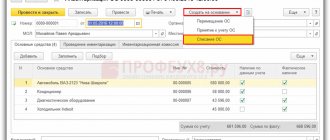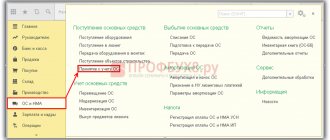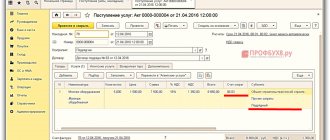In recommendation:
– what is the sequence of actions when taking inventory of fixed assets; – what needs to be done during the inventory; – how to formalize and reflect the inventory results in accounting.
Conduct an inventory of fixed assets (FPE) to:
- determine their actual presence;
- compare actual availability with accounting data;
- check the completeness of reflection in the accounting of liabilities.
Inventory not only your own operating systems, but also those that you rent, use under a loan agreement, or store.
You can learn about the cases in which it is necessary to inventory the OS, what documents this process needs to be completed, and other general rules for conducting an inventory here.
When an inventory is NOT necessary
At the end of each year, you should check whether the accounting data corresponds to the actual presence of assets and liabilities. Property and liabilities recorded off the balance sheet are also subject to inventory (paragraph 2, clause 1.3, clause 3.7 of the Inventory Guidelines).
In fact, property located in the organization that is not accounted for for any reason is also subject to inventory and subsequent acceptance for accounting (paragraph 2, clause 1.3 of the Methodological Instructions for Inventory).
However, before drawing up annual reports, it is not necessary to check the condition of property, the inventory of which was carried out after October 1 of the reporting year. In this way, the inventory can be evenly distributed over the entire fourth quarter. Or an unscheduled audit due to a change in the financially responsible person may be accepted for the purpose of summing up the results of the year.
In addition, an inventory of fixed assets can be carried out once every three years, and of library collections - once every five years. For example, if an organization checked fixed assets in the 4th quarter of 2019, you don’t have to do this again until the 4th quarter of 2022 (clause 27 of Regulation No. 34n and Inventory Guidelines).
What is inventory and when is it carried out?
Inventory is a comparison of accounting data and the actual availability of property, as well as the state of settlements. As part of the inventory, not only tangible assets are checked, but also settlements with debtors and creditors, as well as intangible assets, if the organization has them.
Not only the company’s own assets are subject to verification, but also valuables that are at the disposal of the organization for other reasons. This could be, for example, leased property or customer-supplied raw materials. In accounting, all such objects are reflected in off-balance sheet accounts.
Inventory must be carried out in the following cases (clause 27 of the Regulations approved by order of the Ministry of Finance of the Russian Federation dated July 29, 1998 No. 34n):
- Before preparing annual financial statements. Typically, the annual inventory is carried out in October-November in order to process its results before the end of the year and, if necessary, make changes to the accounting. There are several exceptions to this rule:
A. If the property has already been inventoried for other reasons after October 1 of the current year, then there is no need to check it again.
B. Fixed assets can be checked once every three years, and library funds - once every five years.
B. If the company is located in the Far North or equivalent regions, then the inventory can be carried out not before the annual report, but when the balance of property is minimal. This is due to the fact that most of the cargo is delivered to remote northern areas in the summer, during the navigation period. Therefore, in the fall and early winter, a significant part of the annual supply will still be stored in the company’s warehouses, which will complicate calculations.
- If the property is intended to be sold or rented out.
- Before reorganization or liquidation of the company.
- If facts of theft, damage to property or other abuses are revealed.
- After a natural disaster, fire or other similar emergency.
- When changing materially responsible persons. There is a special situation here - collective (team) financial responsibility. With such responsibility, an inventory must be carried out (clause 1.6 of the Methodological Instructions approved by Order of the Ministry of Finance dated June 13, 1995 No. 49):
A. When changing the foreman.
B. When more than half of the team’s workers are fired
B. At the request of any of the team workers.
In addition, the head of the organization has the right to decide on conducting an inventory in other situations. For example, the director may establish that certain types of material assets should be checked more often: once a quarter or once a month.
All “special” cases of inventory, except for the mandatory ones listed above, must be reflected in the accounting policy (clause 2.1 of order No. 49).
Inventory procedure
The inventory before drawing up the annual financial statements is planned and is carried out in the manner established by the internal documents of the organization. This may be an inventory provision, which is part of the accounting policy in accordance with clause 4 of PBU 1/2008, or another administrative document signed by the head (Letter of the Ministry of Finance of Russia dated 01/09/2020 N 07-01-09/73).
The inventory regulations usually indicate:
- when an inventory is required;
- timing of inventory in the context of property and liabilities;
- document forms used to document inventory results.
When conducting an inventory before preparing annual financial statements, the following general procedure should be followed:
- drawing up a schedule of control activities;
- execution of an order for the appointment of a working inventory commission indicating the place, time and volume of inventory (Resolution of the State Statistics Committee of the Russian Federation dated August 18, 1998 N 88 “On approval of unified forms of primary accounting documentation for recording cash transactions, for recording inventory results”);
- receiving receipts from financially responsible persons (clause 2.4 of the Inventory Guidelines);
- checking the presence and condition, as well as assessing assets and liabilities using the continuous method (clauses 2.7, 2.8 of the Inventory Guidelines);
- checking the availability and storage conditions of documents confirming the location of assets in the ownership or disposal of the organization, as well as technical documentation (clause 3.2 of the Inventory Guidelines);
- identification of assets subject to write-off (clauses 3.6, 3.25, 3.26 of the Inventory Guidelines);
- checking assets for impairment (clause 35 of PBU 4/99);
- identification of doubtful and bad debts (clause 3.8 of the Inventory Guidelines);
- summing up the inventory and processing documents (Resolution of the State Statistics Committee No. 88);
- reflection of inventory results (clause 5.5 of the Inventory Guidelines).
How to conduct an inventory and document its results
Preparing for inventory
At this stage, you need to make a decision on inventory, appoint an inventory commission and collect source documents.
The decision on inventory and the composition of the commission must be approved by order of the head (Form INV-22). This order must be registered in a special accounting journal (INV-23 form).
Hereinafter, we will provide codes of document forms in accordance with Decree of the State Statistics Committee of the Russian Federation dated August 18, 1998 No. 88. These forms are not mandatory for use since 2013, and the organization has the right to approve its forms. But in practice, most companies continue to use familiar forms when conducting inventory.
The inventory commission must consist of at least two people. As a rule, it includes representatives of the company administration and financial services. If the organization has an internal audit unit, then its representative must participate in inventories. Taking into account the specifics of the objects being inspected, other employees may be included in the commission: technical specialists, lawyers, etc.
The financially responsible person (MRP) cannot be a member of the commission, but his presence during the inspection is mandatory.
Before starting the inventory, the commission must receive:
- The latest incoming and outgoing documents or reports that relate to the movement of money and material assets.
- A receipt from the MOL stating that by the beginning of the inventory all incoming and outgoing transactions had been completed, and the latest received documents were transferred to the accounting department or handed over to the inventory commission.
Carrying out an inventory
The procedure for conducting an inventory depends on which accounting objects the commission checks.
- Material assets are checked by actual counting, measuring, weighing, etc. (Clause 2.7 of Order No. 49).
- If the values do not have a material form, then the commission verifies the accounting documents according to their accounting. This method is applied to intangible assets, financial investments and funds in bank accounts (clauses 3.8, 3.14, 3.43 of Order No. 49).
- When taking an inventory of settlements, in addition to checking documents, you also need to carry out a reconciliation with counterparties (clause 3.44 of Order No. 49).
Registration and approval of inventory results
Based on the results of the inventory, special inventories (acts) are drawn up, which are signed by all members of the commission and financially responsible persons.
If the inventory results differ from the accounting data, then, in addition to the inventory, you should also fill out a matching statement. It is necessary to include only those objects for which discrepancies have been identified (clause 4.1 of order No. 49).
Each type of inspected object has its own document forms. For example, for material assets - an inventory in the INV-3 form and a matching sheet in the INV-19 form.
Based on the results of the inventory, the commission holds a meeting, summarizes all the information collected and proposes options for resolving the identified deviations. For summary information, it is convenient to use a statement in the INV-26 form. This document reflects all deviations and the method proposed by the commission for correcting them.
Next, the inventory materials are transferred to the manager, who decides to approve its results. The said decision is formalized by order.
The order and all necessary supporting documents are transferred to the accounting department. Read about how inventory results affect accounting data in the next section.
Summing up the inventory
To formalize the results of the inventory, it is necessary to fill out inventories, acts, statements, using standardized forms (clause 2.10 of the Methodological Instructions for Inventory, Resolution of the State Statistics Committee No. 88). Identified surpluses or shortages are entered into the comparison sheets (forms INV-18 and INV-19) and the list of results identified by the inventory (form INV-26). Based on the results of the annual inventory, the commission usually draws up a protocol.
The presence and correct execution of inventory documents is necessary both to reflect the results in accounting and to resolve disputes if they arise.
The results of the annual inventory are reflected in the annual financial statements (clause 5.5 of the Inventory Guidelines).
Capitalization of surplus
Assets found to be in surplus are subject to capitalization and credited to the financial results of the organization (clause 5.1 of the Methodological Instructions for Inventory).
In tax accounting, surpluses are included in non-operating income at market value (clause 8, clause 20 of Article 250 of the Tax Code of the Russian Federation, Letter of the Ministry of Finance of Russia dated September 11, 2020 N 03-11-06/2/80113). The market value is determined taking into account the provisions of Art. 105.3 of the Tax Code of the Russian Federation (clause 5 and article 274 of the Tax Code of the Russian Federation, Letter of the Ministry of Finance of Russia dated August 28, 2020 N 03-03-06/1/75787). Depreciation can be calculated on capitalized fixed assets, but bonus depreciation cannot be applied.
Inventory and materials are taken into account as usual. This property may be written off or sold. As for sales, the income received as a result of such transactions is reduced by the amount of the market value of the property being sold (accounted for as non-operating income), at which it was accepted for accounting (clause 2, clause 1, article 268 of the Tax Code of the Russian Federation, Letter of the Ministry of Finance of Russia dated September 23 .2011 N 03-03-06/1/583, dated 02/11/2011 N 03-03-06/1/88, Resolution of the Federal Antimonopoly Service of the Moscow Region dated 02/21/2013 in case N A40-2055/12-20-9).
OS Inventory Rules
The main point of inventory is to determine the actual presence and condition of an object in order to adjust the existing accounting data if necessary. This is indicated by the rules for conducting OS inventory (pr. No. 49):
- An object not accepted for accounting, as well as in cases where incorrect data is indicated on it or data is missing, the commission must describe on the spot correctly and completely, include all technical indicators and other indicators for it in the inventory. Example: for buildings, indicate the materials of construction, purpose, measurements, area, number of floors (except for basements), date of construction.
- Market valuation must be applied to any unaccounted for items discovered. Wear is determined based on actual condition. To register such objects, a corresponding act is drawn up.
- In case of actual re-equipment (expansion, reconstruction, restoration), as a result of which the object is used for a different purpose, updated information is entered into the inventory.
- If the commission established that major work was carried out at the facility: premises were added, floors were completed; or a part has been scrapped or liquidated, pay attention to how the object is reflected in accounting. If the changes are not reflected, it is necessary to adjust the book value of the fixed assets based on the data from the primary documentation of the work. The inventory provides information about the changes.
As a general rule, machines, equipment, and transport are entered individually, indicating technical characteristics, manufacturer and other significant data. In some cases, the same type of inventory, machines and tools that have the same cost and are used in one division of the organization are taken into account in the inventory card of the appropriate form as a group. In the inventory they are reflected in one line indicating the actual number of objects.
Objects that have been temporarily removed from their parking areas, are in use, or are located outside the organization’s territory (for example, railway rolling stock, machinery, vehicles undergoing major repairs) must be inventoried in advance, prior to disposal. At the same time, it is advisable to inventory assets that are under repair by entering data into a separate form INV-10 (act). The commission inspects the facility under repair and compares the actual costs of repairs with the planned ones. The act reflects data on savings or overexpenditures, which are subsequently used for analysis and identification of economic reserves. The percentage of technical readiness of the object is indicated.
Separate inventories are compiled on the OS:
- unsuitable for use – completely worn out, damaged (the reason for unsuitability is indicated);
- rented and in safe custody (details of documents confirming rent, safe storage are indicated).
Write-off of shortages
Shortages within the limits of the norms approved by law are written off by order of the manager as production and distribution costs (clause 5.1 of the Inventory Guidelines).
In tax accounting, non-operating expenses take into account shortages of material assets in production and warehouses, at trading enterprises in the absence of culprits, as well as losses from theft, the culprits of which have not been identified. In these cases, the fact of the absence of perpetrators must be documented by an authorized government body (clause 5, clause 2, article 265 of the Tax Code of the Russian Federation).
The norms of the Tax Code of the Russian Federation do not contain instructions on what specific documents need to be obtained in order to confirm the absence of guilty persons, and thus does not limit the taxpayer in confirming the legality of accounting for relevant expenses (Letter of the Ministry of Finance of the Russian Federation dated December 8, 2017 N 03-03-06/ 1/81919).
Documentary evidence may be, in particular, a copy of the resolution of the investigator of the internal affairs bodies of the Russian Federation on the suspension of the preliminary investigation in a criminal case due to failure to identify the person to be brought as an accused (clause 1, paragraph 1, article 208 of the Code of Criminal Procedure of the Russian Federation, Letters of the Ministry of Finance of Russia from 16.12.2011 N 03-03-06/4/149, dated 03.08.2011 N 03-03-06/1/448).
If the guilty person is discovered, then a claim for compensation for losses from the theft of funds can be presented by the organization to the guilty person in accordance with the civil legislation of the Russian Federation. Amounts received to compensate for losses are non-operating income (clause 3 of Article 250 of the Tax Code of the Russian Federation), and the cost of lost property is an expense (clause 20 of clause 1 of Article 265 of the Tax Code of the Russian Federation, Letter of the Ministry of Finance of the Russian Federation dated August 27, 2014 N 03- 03-06/1/42717).
Conclusion
Inventory is a reconciliation of accounting data with the actual presence of values and the state of settlements.
In some cases, it is mandatory, for example, before drawing up an annual report. The director can also decide on an unscheduled inventory.
After the inventory results are approved by the manager, the identified deviations must be reflected in the accounting records. Surpluses are attributed to other income, and shortages, depending on the situation, are attributed to current expenses, guilty parties or other expenses.
Punishment directly for failure to conduct an inventory can only be applied in certain cases, for example, for companies that work with precious metals.
However, if the lack of inventory led to accounting distortion, the company may be fined for this violation. In addition, as part of the bankruptcy procedure, persons guilty of distorting accounting records may be held vicariously liable for the company's obligations.
Write-off of bad debts
Bad debts are written off on the basis of an inventory of payments (form INV-17) and an order from the manager (clause 77 of the Accounting Regulations No. 34n, Article 266 of the Tax Code of the Russian Federation, Letter of the Ministry of Finance of Russia dated December 27, 2018 No. 03-03-06/1/ 95709, dated 10/13/2017 N 03-03-06/1/67057, dated 07/11/2017 N 03-03-06/1/43877).
Uncollectible accounts receivable are subject to write-off against the allowance for doubtful debts. If the reserve is not enough, the remaining debt goes to expenses (Article 265 of the Tax Code of the Russian Federation, Letter of the Ministry of Finance dated January 16, 2018 N 03-03-06/2/1551). In accounting, all organizations are required to create such a reserve; in tax accounting, this is the right of the organization (clause 70 of Regulation No. 34n, Article 266 of the Tax Code of the Russian Federation, Letter of the Ministry of Finance of Russia dated August 31, 2020 No. 03-03-06/2/76195).
The receivable is subject to write-off as expenses along with VAT (Article 266 of the Tax Code of the Russian Federation, Letter of the Ministry of Finance dated October 21, 2008 N 03-03-06/1/596). According to the Ministry of Finance, when writing off debts on advances issued, the VAT accepted for deduction from this advance payment must be restored (Letter of the Ministry of Finance dated January 28, 2020 N 03-07-11/5018).
After write-off, bad receivables are reflected in off-balance sheet account 007 for five years (clause 77 of Regulation No. 34n).
Under the simplified tax system, written-off receivables are not taken into account either in expenses or in income (Letters of the Ministry of Finance dated 02/20/2016 N 03-11-06/2/9909, dated 07/22/2013 N 03-11-11/28614).
Bad accounts payable are taken into account as income under both the OSNO and the simplified tax system (clause 78 of Regulation No. 34n, clause 2, clause 1, article 248, clause 18, article 250, clause 1, article 346.15 of the Tax Code of the Russian Federation). If an organization uses the simplified tax system to write off the creditor for the advance received from the buyer, then no income will arise, because income is reflected as the advance payment is received (clause 1 of Article 346.17 of the Tax Code of the Russian Federation, Letter of the Ministry of Finance of Russia dated March 14, 2016 N 03-11-06/2/14135).
Writing off accounts payable to the supplier does not oblige the buyer to restore VAT previously accepted for deduction (Letter of the Ministry of Finance dated June 21, 2013 N 03-07-11/23503). When a creditor writes off an advance received, the VAT calculated on it cannot be deducted. There is no need to include it in income or expenses (Article 248 of the Tax Code of the Russian Federation, Letter of the Ministry of Finance dated December 7, 2012 N 03-03-06/1/635).
Features of the annual inventory in 2021
When conducting an inventory before preparing reports for 2020, you should take into account the latest changes in accounting legislation.
From 2021, a new accounting standard will be mandatory.
Two standards have been approved, the application of which is mandatory from reporting for 2022, but if you wish, you can switch to the new rules earlier: FSBU 6/2020 “Fixed Assets” and FSBU 26/2020 “Capital Investments” (Order of the Ministry of Finance of Russia dated September 17, 2020 N 204n ).
This may require the organization to take a more thorough approach to checking and reflecting balances in accounting and reporting.
In addition, at the end of 2021, settlements with accountable persons and inventory of balances on account 71 deserve special attention.
This is due to the forced cancellation of business trips due to coronavirus restrictions and the need for many taxpayers to adjust their plans.
Penalty for failure to take inventory
The tax inspectorate or other government agencies cannot fine an organization simply because it did not conduct an annual inventory. There is no such fine in the law.
However, without inventory:
- it is impossible to obtain a positive audit opinion;
- accounting statements may be unreliable, which entails fines both for the organization itself and for its officials (Article 120 of the Tax Code of the Russian Federation; Article 15.11 of the Code of Administrative Offenses of the Russian Federation);
- errors in tax accounting, additional charges of taxes, penalties and fines are possible (Articles 75, 120, 122 of the Tax Code of the Russian Federation).




